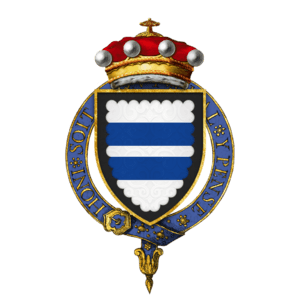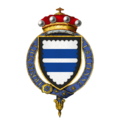William Parr (died 1483) facts for kids
Quick facts for kids
William Parr
|
|
|---|---|

Coat of Arms of Sir William Parr, KG
|
|
| Born | 1434 |
| Died | 1483 (aged 48–49) |
| Noble family | Parr |
| Spouse(s) | Joanna Trusbut Elizabeth FitzHugh |
| Issue | Anne Parr Sir Thomas Parr, Lord of Kendal William Parr, 1st Baron Parr of Horton John Parr, Esq |
| Father | Sir Thomas Parr of Kendal |
| Mother | Alice Tunstall |
Sir William Parr (1434–1483) was an important English courtier and soldier. He was given the special title of Knight of the Garter (KG). William was the oldest son of Sir Thomas Parr (1405–1461) and Alice Tunstall.
Contents
The Parr Family History
The Parr family came from a place called Parr in Lancashire, England. Sir William's great-grandfather, also named Sir William de Parre, married Elizabeth de Ros in 1383. Elizabeth was from a powerful family and inherited a lot of land, including parts of Kendal Castle and the barony of Kendal. This marriage made the Parr family much more important.
The family lived at Kendal Castle for a while. But the castle later became old and broken down.
William's Grandparents
William Parr's grandparents on his father's side were Sir John Parr of Kendal and Agnes Crophull. His grandparents on his mother's side were Sir Thomas Tunstall of Thurland Castle and Isabel Harrington. Through his mother's family, William was a cousin to Bishop Cuthbert Tunstall.
William's Father
Sir Thomas Parr, William's father, was a Member of Parliament (MP) six times. He was also a deputy sheriff for Westmorland. He played an active part in the Wars of the Roses, which were battles between two powerful families, the Yorkists and the Lancastrians. Sir Thomas supported the Yorkist side. He died in 1464.
William's father had three sons and six daughters. William was the oldest. His second son, Sir John Parr, also supported the Yorkists. His third son, Thomas, died in battle in 1471. All of William's sisters married into important families in the north of England.
William Parr's Life
William Parr was involved in the politics and wars of his time. He was part of a rebellion against King Edward IV in 1469. This rebellion was led by Richard Neville, the Earl of Warwick, and the King's brother, George, Duke of Clarence.
The Battle of Edgcote
William Parr was one of the commanders of the rebel forces at the Battle of Edgcote in July 1469. The rebels defeated the King's forces. After this battle, King Edward IV was captured by Warwick. However, Edward was later released.
Returning to the King's Side
When King Edward IV returned from being exiled in 1471, William Parr joined him. He brought 600 soldiers to help the King. William fought with Edward at the Battle of Barnet. Sadly, his younger brother was killed in this battle.
After Edward IV regained his throne, William Parr was rewarded for his loyalty. He became the Comptroller of the Household, which meant he managed the King's royal home. He also received large land grants, including parts of the Kendal barony and several castles like Burgh, Pendragon, and Appleby.
In 1472, Sir William Parr promised to support Edward, Prince of Wales, as the next king. He was also a Member of Parliament for Westmorland in 1467 and 1473. In 1474, he was made a Knight of the Garter, a very high honor.
After King Edward IV's Death
After King Edward IV died, William Parr supported Richard, Duke of Gloucester, who became the new King. However, William Parr chose not to attend King Richard III's coronation in 1483. His wife and mother-in-law did attend, serving the new Queen.
Sir William Parr died shortly after, in February 1484.
William's Marriages and Children
Sir William Parr married twice.
First Marriage
His first wife was Joan Trusbut. She died in 1473. They did not have any children who survived.
Second Marriage
His second wife was Elizabeth FitzHugh. She was the daughter of Henry, 5th Baron FitzHugh. Elizabeth survived William and later remarried.
William and Elizabeth had five children:
- Anne Parr (born around 1476 – died 1513)
- Sir Thomas Parr (died 1517), who became Lord of Kendal.
- Sir William Parr, 1st Baron Parr of Horton (died 1547).
- Alice Parr (died young).
- John Parr (died 1508).
Notable Children
William's oldest son, Sir Thomas Parr, was knighted and became very wealthy. He married Maud Green. Their children included:
- Catherine Parr, who later became the last queen of King Henry VIII.
- William Parr, who became a Marquess.
- Anne Parr, who married William Herbert, Earl of Pembroke.
William's second son, also named William, was knighted in 1513. He became a Baron in 1543, known as Baron Parr of Horton. He had four daughters.
William's third son, John, married Constance Vere, but they had no children.
Images for kids


